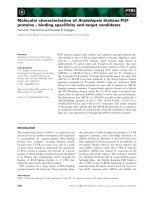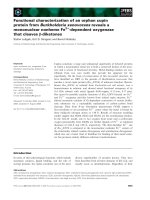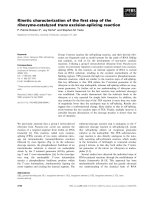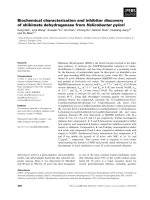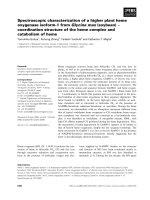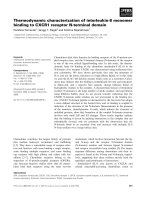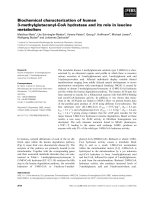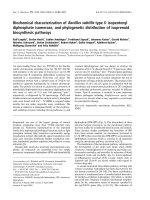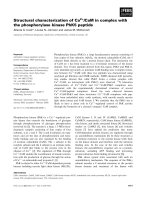Báo cáo khoa học: Biochemical characterization of annexin B1 from Cysticercus cellulosae pdf
Bạn đang xem bản rút gọn của tài liệu. Xem và tải ngay bản đầy đủ của tài liệu tại đây (702.93 KB, 10 trang )
Biochemical characterization of annexin B1 from
Cysticercus cellulosae
Anja Winter
1
, Adlina M. Yusof
1
, Erning Gao
1
, Hong-Li Yan
2
and Andreas Hofmann
1
1 Institute of Structural & Molecular Biology, School of Biological Sciences, The University of Edinburgh, UK
2 Department of Medical Genetics, The Second Military Medical University, Shanghai, China
Annexins are water-soluble, calcium-dependent phos-
pholipid-binding proteins. Members of the annexin
family are ubiquitously distributed in different tissues
and cell types of higher and lower eukaryotes. To date,
over 160 unique annexin proteins have been found in
more than 65 different species ranging from fungi and
plants to nonvertebrates and higher vertebrates [1].
Their abundance, as well as their calcium-regulated
presence at cell membranes, makes members of this
family versatile adapter and regulator proteins in
membrane-associated processes. Accordingly, a role in
endo- and exocytosis has been assigned to many ann-
exin proteins [2,3]. Despite being intracellular proteins,
extracellular functions have been described for several
annexins. Whereas annexin A2 is known to act as a
coreceptor for plasminogen and tissue plasminogen
activator on the surface of endothelial cells [4], annex-
in A1 has been observed to bind to an extracellular
domain of b
2
integrin [5]. Annexin A5 was found to
bind to the intracellular part of the b
5
integrin receptor
Keywords
annexins; calcium; heparin; protein–
glycosaminoglycan interactions; protein–
membrane interactions
Correspondence
A. Hofmann, Institute of Structural &
Molecular Biology, School of Biological
Sciences, The University of Edinburgh,
The King’s Buildings, Mayfield Road,
Edinburgh EH9 3JR, UK
Fax: +44 131 650 8650
Tel : +44 131 650 5365
E-mail:
(Received 7 March 2006, revised 7 April
2006, accepted 22 May 2006)
doi:10.1111/j.1742-4658.2006.05332.x
Annexin B1 from Cysticercus cellulosae has recently been identified using
immunological screening in an attempt to find novel antigens for vaccine
development against cysticercosis. The protein possesses anticoagulant
activity and carries significant therapeutic potential due to its thrombus-
targeting and thrombolytic properties. We investigated the biochemical
properties of annexin B1 using liposome and heparin Sepharose copelleting
assays, as well as CD spectroscopy. The calcium-dependent binding to aci-
dic phospholipid membranes is reminiscent of other mammalian annexins
with a clear preference for high phosphatidylserine content. A unique prop-
erty of annexin B1 is its ability to bind to liposomes with high phosphat-
idylserine content in the absence of calcium, which might be due to the
presence of several basic residues on the convex protein surface that har-
bours the membrane-binding loops. Annexin B1 demonstrates lectin prop-
erties and binds to heparin Sepharose in a cooperative, calcium-dependent
manner. Although this binding is reversible to a large extent, a small frac-
tion of the protein remains bound to the glycosaminoglycan even in the
presence of high concentrations of EDTA. Analogous to annexin A5, we
propose a model of heparin wrapped around the protein thereby engaging
in calcium-dependent and calcium-independent interactions. Although the
calcium-independent heparin-binding sites identified in annexin A5 are not
conserved, we hypothesize three possible sites in annexin B1. Results from
CD spectroscopy and thermal denaturation indicate that, in solution, the
protein binds calcium with a low affinity that leads to a slight increase in
folding stability.
Abbreviations
LUV, large unilamellar vesicle; PtdCho, phosphatidylcholine; PtdSer, phosphatidylserine.
3238 FEBS Journal 273 (2006) 3238–3247 ª 2006 The Authors Journal compilation ª 2006 FEBS
subunit [6]. Annexins A2 and A5 have repeatedly been
reported to act as cellular receptors for cytomegalo-
virus and hepatitis B virus [7–9], although this is still
a matter for discussion within the community. Fre-
quently, annexins are found to interact with cytoskele-
tal proteins. Annexins A1 [10] and A2 [11], as well as
the plant annexins p34 and p35 from tomato [12], exhi-
bit binding to F-actin, and others, for example plant
annexins from corn [13], bell pepper [14] and cotton
[15], tested negative in this context. Interactions
between annexin A1 and profilin have also been dem-
onstrated [16].
The glycosaminoglycan heparan sulfate is ubiqui-
tously distributed on the surface of cells and acts as a
regulator of ligand–receptor encounters [17], promotes
protein assembly [18] and thus coordinates a variety of
cellular functions. Heparan sulfate has a variable hep-
arin-like structure but more N-acetylated and fewer
N-orO-sulfonated groups than heparin. Heparin itself
is a highly potent anticoagulant due to its ability to
activate serine protease inhibitors such as antithrombin
[19].
Several annexins, including annexins A1 [16], A2
[20], A4 [21], A5 [21–24], A6 [21] and Nex1 [25], are
known to possess glycosaminoglycan-binding proper-
ties. The crystal structure of annexin A5 in complex
with heparin-derived tetrasaccharides revealed two
binding sites, a calcium-mediated one residing on the
convex side and a calcium-independent one on the
concave side of the protein [24]. In that study, Capila
et al. presented a model in which the heparin chain is
wrapped around the annexin molecule occupying both
binding sites. Whereas binding of the carbohydrate to
the site on the concave surface of the protein most
likely does not interfere with the essential annexin–
membrane association, the site on the convex surface
would be affected by membrane binding. However,
in vitro studies showed that heparin binding cannot
compete effectively with phospholipid membrane bind-
ing to annexin A5 [21,26]. Therefore, heparin might be
displaced from the binding site on the convex surface
of annexin A5 upon competition by phospholipid mol-
ecules, e.g. when membrane binding occurs. In the sol-
uble state, calcium binding contributes to the overall
affinity of the annexin A5–heparin interaction. Thus,
the annexin A5–heparin interaction is calcium-depend-
ent in vitro, but is thought to carry less significance
in vivo [24].
The implications of annexin proteins in health and
disease are increasingly being appreciated and the term
‘annexinopathies’ has been put forward for annexin-
related diseases. In particular, the importance of
annexin A1 in inflammation [27] and annexin A2 in
plasminogen-dependent fibrinolysis [28] has long been
appreciated. In recent years, the role of membrane-
bound annexin A5 as a protective shield has clarified the
molecular mechanisms of its anticoagulant properties
[29]. Altered gene regulation and ⁄ or distribution of
annexins have been observed for a variety of conditions.
Cysticercosis is an infection by Cysticercus cellulo-
sae, the larva of the pig tapeworm Taenia solium. The
condition seriously affects human health and also leads
to economic losses in some developing countries. Infec-
tion occurs mostly in the CNS, muscles, subcutaneous
tissue and the globe of the eye [30]. In an attempt to
find novel antigens for vaccine development, annex-
in B1 was identified by immunological screening of a
C. cellulosae library [31]. The ability of annexin B1 to
displace phospholipid-dependent coagulation factors
and to prolong clotting times of human serum empha-
sizes its potential for antithrombotic treatments. The
combination of thrombus-targeting and thrombolytic
properties has also been suggested for the protein [32].
To date, there has been no systematic characterization
of the molecular properties of annexin B1. All the
literature reports have mainly concentrated on identifi-
cation and probable functions of the protein.
Similar to other annexins, annexin B1 comprises a
tetrad repeat of 70 amino acids and possesses all the
highly conserved residues generally found in other
annexins involved in salt bridge interactions. The land-
mark feature of annexins is their ability to bind to
acidic phospholipid membranes in the presence of
calcium, which is facilitated by calcium ions coordina-
ted within the AB and DE loop areas. Accordingly,
this feature has also been observed with annexin B1
[32,33] although the primary structure (Fig. 1) suggests
that the calcium-binding site in the third domain is dis-
rupted due to a lysine (K254). This lysine occupies the
position of the bidentate residue in the DE loop
required for calcium coordination by the endonexin
sequence [34]. Annexin B1 shares 35% amino acid
identity with hydra annexin B12 and human annex-
in A5. Further distinct features of annexin B1 include
the slightly longer N-terminal domain ( 30 amino
acids), as well as a connector region between domains
II and III. The connector region of this protein com-
prises of 30 amino acids compared with annexins A5
and B12, which have an insertion of 14 residues.
To learn more about the molecular evolution of
annexins, as well as to characterize the molecular
properties of annexin B1, we set out to characterize
the protein biochemically and biophysically.
In this study, we investigated the binding behaviour
of annexin B1 to heparin and phospholipid vesicles
in a calcium-dependent manner. Although the protein
A. Winter et al. Biochemical characterization of annexin B1
FEBS Journal 273 (2006) 3238–3247 ª 2006 The Authors Journal compilation ª 2006 FEBS 3239
shares the feature of binding membranes calcium-inde-
pendently with its plant relatives, the ability to bind
heparin is reminiscent of mammalian annexins. Fur-
thermore, we developed an inexpensive purification
procedure that produces protein amounts comparable
with other protocols.
Results
Production of native annexin B1
Whereas recombinant annexin B1 has previously been
purified either by ion-exchange chromatography [32]
or liposome-affinity using proteoliposomes formed
from disintegrated cell membranes [33], we explored
the possibility of obtaining the protein by heparin-
affinity chromatography [35]. After an initial anion-
exchange chromatography step, annexin B1 was bound
to heparin-Sepharose in the presence of 5 mm calcium
and eluted, after extensive washing, by the application
of an EDTA-containing buffer (Fig. 2). In SDS ⁄
PAGE, the protein migrates at an apparent molecular
mass of 38 kDa.
This protocol yields up to 10 mg proteinÆL
)1
bacter-
ial culture with a purity of > 95%, as determined by
MS. As such, this procedure results in comparable
quantity and quality of protein as other methods.
However, it is more convenient than the protocol
based on liposome-affinity, due to utilization of
re-usable affinity chromatography resin.
Protein fold and folding stability
The CD spectra of recombinant annexin B1 in the
absence and presence of 5 mm calcium did not show a
significant difference (Fig. 3A). Therefore, in solution,
the secondary structure of the protein is not affected
by calcium, an observation also seen in many other
annexins.
Denaturation studies as monitored by CD indicate
that there is one transition in heat-induced unfolding
and that the presence of 5 mm calcium shifts the trans-
ition temperature by 6 K (Fig. 3B, Table 1). This situ-
ation is also seen in mammalian annexins such as
annexin A5. Annexin B1 thus unfolds as one folding
unit and the presence of calcium slightly stabilizes the
protein.
Heparin binding
Calcium-dependent binding of annexin B1 to heparin
was investigated using a centrifugation assay with hep-
arin Sepharose beads. After binding the protein onto
the beads in the presence of various calcium concentra-
tions, the beads were washed once while maintaining
the calcium concentrations. A washing step with cal-
cium was performed to exclude possible artefacts from
unspecific binding to the heparin matrix, and the
amount of (reversibly) bound protein was determined
from the EDTA eluate. As seen from Fig. 4B, the data
for annexin B1 suggests a cooperative binding beha-
Fig. 1. Amino acid alignment of annexin B1
from C. cellulosae (GenBank accession nu-
mber AF147955), annexin B12 from Hydra
vulgaris (GenBank accession number P2625-
6) and human annexin A5 (GenBank acces-
sion number P08758). The endonexin
sequence in all four domains is highlighted.
The heparin binding sites HTS-1 (Arg207)
and HTS-3 (Arg25) [24] are highlighted in
bold. The predicted heparin binding site
HTS-2 including Arg289 [45] is underlined.
The potential heparin binding sites in annex-
in B1 are highlighted by bold italics. Align-
ment was calculated with the program
MUSCLE [46].
Biochemical characterization of annexin B1 A. Winter et al.
3240 FEBS Journal 273 (2006) 3238–3247 ª 2006 The Authors Journal compilation ª 2006 FEBS
viour with respect to calcium that can be fitted with a
Hill equation using a Hill coefficient of n ¼ 3. For
comparison, annexin A1 displays a binding behaviour
with less cooperativity (n ¼ 1.7; Fig. 4C). Comparing
the binding curves of the two proteins, we can thus
rule out the possibility that the lag phase observed
with annexin B1 is due to an artefact within the assay.
For both proteins, the maximal binding degree, as
determined from the supernatant of the EDTA elution
step, is only 60–70%. We therefore analysed the
heparin Sepharose resin pellet in the EDTA elution
step and found that not all of the protein could be
released from the resin. The amount of irreversibly
bound protein increases with higher calcium concentra-
tions and reaches between 10 and 20% at 10 mm cal-
cium for both annexins. Importantly, no annexin B1
12 3 45 6 7 8910
1234567
8
910
kDa
A
B
158
116
97.2
66.4
55.6
42.7
36.5
26.6
20.0
kDa
158
116
97.2
66.4
55.6
42.7
36.5
26.6
20.0
Fig. 2. Purification of native annexin B1. Fractions of the chroma-
tography purification subjected to SDS ⁄ PAGE and stained with
Coomassie Brilliant Blue. (A) After harvesting and lysing the cells,
the cell lysate was applied to anion-exchange chromatography
using Q-Sepharose. Shown are the molecular mass marker (lane 1),
cell lysate (lane 2), flow-through (lane 3), wash (lane 4), elution frac-
tions from 120 to 300 m
M NaCl (lanes 5–10). (B) Affinity chroma-
tography using heparin Sepharose. Protein-containing fractions from
the anion-exchange chromatography were pooled, dialysed against
a buffer containing 5 m
M CaCl
2
and applied to the heparin column.
Shown are the molecular mass marker (lane 1), flow-through from
the loading step (lane 2), wash (lane 3), and elution fractions after
applying 10 m
M EDTA (lanes 4–10).
Fig. 3. Protein fold and folding stability. (A) Far-UV CD spectra of
annexin B1 in the absence (dashed line) and presence (solid line) of
5m
M CaCl
2
. (B) Thermal unfolding of annexin B1 in the absence
(open circles, dashed line) and presence (closed diamonds, solid
line) of 5 m
M CaCl
2
. The CD at 222 nm was monitored as des-
cribed in Experimental procedures. The fit of the average of three
independent experiments in the absence and presence of CaCl
2
is
represented by the dashed and solid line, respectively.
Table 1. Thermal denaturation of annexin B1. The values for AnxA5
are given for comparison.
Protein
T
1/2
(°C)
Without Ca
2+
T
1/2
(°C)
5m
M Ca
2+
D(T
1/2
)
(K)
AnxB1 52 58 +6
AnxA5 [38] 52 59 +7
A. Winter et al. Biochemical characterization of annexin B1
FEBS Journal 273 (2006) 3238–3247 ª 2006 The Authors Journal compilation ª 2006 FEBS 3241
was found to bind to the resin at low levels of calcium
(0–1 mm). Results from a precipitation assay show that
only insignificant amounts of annexin B1 precipitate in
the range of 0–10 mm calcium (data not shown).
Membrane binding
The calcium-dependent membrane binding of annex-
in B1 was assessed using large unilamellar vesicles
(LUVs) with two different phosphatidylserine (PtdSer)
contents (Fig. 5 and Table 2). The protein displays a
calcium-dependent binding behaviour to PtdSer ⁄ phos-
phatidylcholine (PtdCho) (1 : 3) vesicles, albeit only to
a moderate extent with a maximal binding of 30%
at 10 mm calcium. In contrast, the binding is more
enhanced with PtdSer⁄ PtdCho (3 : 1) vesicles. Here,
the maximal binding degree at 10 mm calcium is 90%
and the half-maximal calcium concentration of 0.1 mm
is at the lower end of the range observed with several
plant annexins [36].
More interestingly, using PtdSer ⁄ PtdCho (3 : 1) lipo-
somes, annexin B1 exhibits calcium-independent bind-
ing with a binding degree of 50%. This behaviour is
1234567
A
B
C
Fig. 4. Calcium-dependent binding of annexin B1 to heparin resin.
(A) A representative SDS ⁄ PAGE of calcium-dependent annexin B1
binding to heparin Sepharose. Lane 1 is the amount of 100% pro-
tein (‘Master sample’). Lanes 2–7 are the EDTA-elicited superna-
tants of samples with varying calcium concentrations (0, 0.5, 1, 2,
5, 10 m
M). (B) Calcium-dependent binding of annexin B1 to heparin
Sepharose displays a cooperative behaviour with respect to cal-
cium. The degree of reversibly (closed circles) and irreversibly
(open circles) bound annexin B1 was determined as outlined in
Experimental procedures. Each data point represents the average
of at least three independent experiments. The solid lines represent
the fit of data to binding equations with a Hill coefficient of n ¼ 3.
(C) Annexin A1 binds to heparin Sepharose in a calcium-dependent
manner with lower cooperativity (n ¼ 1.7) than annexin B1. The
degree of reversibly and irreversibly bound protein is shown as
closed and open triangles, respectively. Each data point represents
the average of at least three independent experiments. The solid
lines represent the fit of data to binding equations.
Fig. 5. Membrane binding of annexin B1 to liposomes. Membrane-
binding of annexin B1 to PtdSer ⁄ PtdCho (1 : 3) (d to solid line) and
PtdSer ⁄ PtdCho (3 : 1) (s to dashed line) liposomes. The lines rep-
resent the fit of a standard binding equation to the data (one bind-
ing site). The data points are the average of at least three
independent measurements.
Table 2. Calcium-dependent phospholipid binding of annexin B1.
Liposome
composition
c
1 ⁄ 2
(Ca
2+
)
(m
M)
Binding at
c(Ca
2+
) ¼
0m
M (%)
Maximum
binding at
c(Ca
2+
) ¼
10 m
M (%)
PtdSer ⁄ PtdCho (1 : 3) – 0 30
PtdSer ⁄ PtdCho (3 : 1) 0.13 50 90
Biochemical characterization of annexin B1 A. Winter et al.
3242 FEBS Journal 273 (2006) 3238–3247 ª 2006 The Authors Journal compilation ª 2006 FEBS
akin to that seen from bell pepper and cotton annex-
ins, although the latter proteins have a less stringent
requirement for PtdSer in this context [36].
Discussion
Denaturation studies
As seen from thermal denaturation, annexin B1
unfolds as one folding unit similar to most of its mam-
malian relatives. The only notable exception is annexin
A3 where the N-terminal domain acts as a second
unfolding unit due to the Trp5-mediated anchorage of
the N-terminal tail to the core of the protein [37].
Although the calcium affinity of annexin proteins in
the absence of phospholipids is rather low with micro-
molar and millimolar dissociation constants, a stabil-
ization effect has been observed with mammalian
annexins, in particular annexin A5, in the presence of
calcium [38]. We report the same effect with annexin
B1 which displays a higher folding stability in the pres-
ence of calcium as indicated by an increase of 6 K in
its transition temperature. This increase is comparable
with that observed with annexin A5.
Membrane binding
Annexin B1 exhibits the landmark feature of calcium-
dependent binding to acidic phospholipid membranes
shared by all annexins studied to date. A comparison
of low and high PtdSer containing LUVs yields only
poor annexin binding to PtdSer ⁄ PtdCho (1 : 3) vesi-
cles, but enhanced binding to PtdSer ⁄ PtdCho (3 : 1)
vesicles. Intriguingly, calcium-independent binding up
to 50% is observed with the latter vesicles. This
behaviour deviates from that of mammalian annexins
which rely almost entirely on a calcium-mediated bind-
ing mode regardless of the vesicle composition. In con-
trast, recent results demonstrate that some plant
annexins employ a second, calcium-independent mech-
anism that utilizes conserved exposed surface residues,
including Trp35, Trp107 and Lys190 [annexin 24
(Ca32) numbering] [36]. One can therefore speculate
that annexin B1 employs a similar mechanism whereby
exposed residues on the convex surface engage in
direct interactions with the membrane. From the three
identified residues in plant annexins, only Lys190 is
semiconserved in annexin B1 by Arg214. However, it
is possible to identify a number of exposed basic resi-
dues on the convex surface of the protein. The involve-
ment of these basic residues would help to explain the
observation that a high PtdSer content in the mem-
brane is required in order to bind annexin B1.
It is worth noting that, in contrast to mammalian
annexins, plant annexins apparently have fewer than
four canonical type II calcium binding sites. One could
imagine that the calcium-independent membrane bind-
ing mechanism assists the calcium-driven membrane-
binding process which might be less efficient, in case of
dysfunctional calcium binding sites. The development
of four canonical calcium-binding sites in certain
annexins (predominantly later in evolution) might have
made the calcium-independent mechanisms obsolete.
The observation of calcium-independent membrane
binding by annexin B1 fits well with this hypothesis,
because one can anticipate a disrupted canonical cal-
cium-binding site in domain III of this protein.
Heparin binding
Results from the heparin-binding assay show that ann-
exin B1 possesses lectin properties. The protein binds
to glycosaminoglycan in a calcium-dependent manner
and displays cooperativity with respect to calcium.
This latter feature is less pronounced in annexin A1,
which was used as a control in this study. The binding
data can be fitted assuming the presence of three bind-
ing sites which coincides with the fact that annexin
B1 only has three canonical type II binding sites.
It remains to be clarified whether all three binding
sites engage in calcium-dependent glycosaminoglycan
binding.
Interestingly, between 10 and 20% of both annexins
remain bound to the glycosaminoglycan even after
extraction with high concentrations of a chelating
agent. Unspecific binding to the heparin matrix can be
excluded due to an intermediate washing step and the
fact that no protein was found to bind to the glycos-
aminoglycan in the absence of calcium. Based on
results from precipitation assays, we can also rule out
artefacts caused by calcium-mediated protein aggrega-
tion. Apparently, the protein is dependent on calcium
ions to initially form interactions with heparin. Once
bound, a fraction of the protein undergoes a shift in
binding mode which ‘irreversibly’ attaches it to the
glycosaminoglycan.
For annexin A5, a model of heparin binding has
been put forward in which recognition and binding of
heparin occurs on the concave side of the protein via
the two binding sites HTS-1 (Arg207–Lys208) and
HTS-2 (Arg285–Lys286–X–X–Arg289–Lys290) [24].
However, the HTS-3 (Arg25–Lys26) site on the convex
surface is not involved in the recognition process but
significantly increases the affinity of the interaction
with heparin. Subsequent binding of annexin A5 to the
membrane surface releases the glycosaminoglycan from
A. Winter et al. Biochemical characterization of annexin B1
FEBS Journal 273 (2006) 3238–3247 ª 2006 The Authors Journal compilation ª 2006 FEBS 3243
the HTS-3 site because its affinity for the phospholipid
membrane is considerably higher [26]. In this latter
state, the protein is attached to the membrane surface
via its convex site and the heparin is bound with the
binding sites only on the concave side. One could envi-
sion a similar mechanism with annexin B1, in which
the calcium-dependent binding step occurs through the
calcium-binding sites on the convex domain. Assuming
the presence of further heparin-binding sites elsewhere
on the protein surface, annexin B1 can remain bound
to the glycosaminoglycan even in the absence of cal-
cium ions. In this context, the amino acid sequence
alignment of annexins A5 and B1 reveals that only the
HTS-3 site of annexin A5 (Arg25–Lys26) is conserved
in annexin B1 (Lys38–Arg39), which may thus act in
the same manner as in its mammalian relative. The
binding sites on the concave surface (HTS-1 and HTS-
2) are not observed with annexin B1, although a K-E-
K motif is present instead of the R-K-X-X-R-K motif
of HTS-1. However, two other sites in annexin B1
merit attention. The motifs Arg91–Arg92 and Lys139–
Lys140 on the concave sides of domains I and II,
respectively, could be potential calcium-independent
heparin binding sites. A further possible motif,
Lys254–Lys255 is found in the DE loop of domain III,
which is located in the anticipated dysfunctional
canonical calcium binding site. Nevertheless, occupa-
tion of this site by heparin would compete with bind-
ing to the membrane surface. Further studies to test
these hypotheses are currently under way.
Several viruses and parasites have infection strat-
egies based on binding to proteoglycans in the extra-
cellular matrix. Binding to the carbohydrates of
proteoglycans is a crucial step in attachment, inva-
sion and cytolysis of intestinal epithelium by para-
sites. Obviously, this requires the invader to have
glycosaminoglycan-binding proteins. Prominent exam-
ples are microbial adhesions, including the influenza
haemagglutinin, as well as the adhesins from Shiga
toxin and Entamoeba histolytica [39]. Annexin B1 has
been shown to be highly immunogenic [31], and is
potentially present on the surface of C. cellulosae.
The binding behaviour of the protein to heparin as
determined in this study may therefore be a mechan-
ism used by C. cellulosae to attach and invade host
tissue.
Experimental procedures
Production of native annexin B1
Annexin B1 cDNA was cloned into the bacterial expression
vector pRSET_6c [40] using PCR amplification to engineer
NdeI and XhoI restriction sites. The construct was obtained
with a P346H mutation.
The construct was expressed in Escherichia coli strain
BL21(DE3). A total of 8 L of Luria–Bertani medium
(50 mgÆL
)1
ampicillin) was inoculated with an overnight
culture of 1 L. The cells were grown at 37 °C until the
absorbance at 600 nm exceeded 1.0. Induction was carried
out with 0.5 mm isopropyl thio-b-d-galactoside. Cell
growth was then continued for 14–16 h before being har-
vested. The cell pellets were resuspended (100 mm NaCl,
1.5 mm EDTA, 5 mm benzamidinium chloride, 1 mm phe-
nylmethylsulfonyl fluoride, 0.1% Triton X-100, 20 mm Tris,
pH 8.0) and lysed by freeze–thaw and sonication. Cell deb-
ris was separated by centrifugation for 45 min, 60 000 g,
and 4 °C.
The protein was purified in two steps, anion exchange
chromatography using Q-Sepharose resin, and heparin
affinity chromatography. The anion-exchange column was
equilibrated with 20 mm Tris, pH 9.0 and the supernatant
from the centrifugation step was applied. After extensive
washing with equilibration buffer, a linear NaCl gradient
was applied and the protein eluted from 150 to 300 mm
NaCl. The pooled fractions obtained from this step were
dialysed against the equilibration buffer for heparin-affinity
chromatography (5 mm CaCl
2
, 250 mm NaCl, 50 mm Tris,
pH 9.0) and loaded onto a heparin Sepharose column.
After extensive washing, the protein was eluted by applying
buffer containing EDTA (10 mm EDTA, 250 mm NaCl,
50 mm Tris, pH 9.0). Fractions containing annexin B1 were
pooled and concentrated using 10 kDa molecular mass cut-
off Vivaspin concentrators (Vivascience, Fisher Scientific,
Loughborough, UK). SDS ⁄ PAGE analysis was performed
throughout the purification process. The identity and purity
of annexin B1 was confirmed using MALDI-TOF. The
whole procedure yields 8 mg proteinÆL
)1
of cell culture.
Heparin-binding assay
Calcium-dependent binding of annexin B1 to heparin was
studied by a centrifugation assay using heparin Sepharose.
For the assay, 1 mL suspension of heparin Sepharose
(Amersham Pharmacia Biotech, Piscataway, NJ) was equili-
brated by washing three times with 3.5 mL buffer (100 mm
NaCl, 20 mm Tris, pH 8.0). All centrifugation steps were
carried out for 3 min, 3000 r.p.m., 4 °C. The resin was
finally resuspended in 4 mL protein buffer and distributed
into six aliquots. After centrifugation, the supernatant was
removed and CaCl
2
was added to the protein buffer (total
volume 390 lL) to yield varying concentrations of calcium
(0, 0.5, 1, 2, 5 and 10 mm). Finally, 10 lL of annexin B1
(1–5 mgÆmL
)1
) was added to each aliquot. After 10 min
incubation at room temperature, the samples were subjected
to centrifugation. The pellets were then washed with
400 lL protein buffer with the appropriate calcium concen-
tration and the samples were centrifuged again. The protein
Biochemical characterization of annexin B1 A. Winter et al.
3244 FEBS Journal 273 (2006) 3238–3247 ª 2006 The Authors Journal compilation ª 2006 FEBS
was eluted with 400 lL of protein buffer containing 30 mm
EDTA. After centrifugation, the supernatant was run on
SDS ⁄ PAGE (Fig. 4A). The amount of reversibly bound
annexin was determined by densitometric analysis of the
Coomassie Brilliant Blue-stained gels using the program
imagej [41].
Liposome-based copelleting assay
Phospholipid vesicles were prepared from 1,2-dioleoyl-sn-
glycero-3-phosphoserine and 1,2-dioleoyl-sn-glycero-3-phos-
phocholine (Avanti Polar Lipids, Alabaster, AL, USA)
according to the protocol of Reeves & Dowben [42]. The
vesicles were converted into LUVs using five freeze–thaw
cycles and subsequent extrusion (11 times) through 0.1 lm
filter membranes using an extruder (Avanti Polar Lipids) at
37 °C. To assess the annexin–membrane binding behaviour,
a copelleting assay was conducted [43]. A total of 0.2 lmol
phospholipids was used for each individual sample
(500 lL), composed of 0.5 nmol protein in liposome buffer
and varying amounts of calcium (0, 1, 2, 10 and 20 mm).
As a control, a sample of 0.1 nmol protein in 100 lLof
10% SDS was prepared at this stage. All samples were cen-
trifuged (45 min, 13000 r.p.m., 4 °C), the pellets resuspend-
ed with 50 lL of 10% SDS and subjected to SDS ⁄ PAGE.
Gels were stained with Coomassie Brilliant Blue and ana-
lysed densitometrically using the program imagej [41]. Each
calcium concentration was assessed three times independ-
ently. Curve fitting was performed with sigmaplot.
Calcium-dependent aggregation ⁄ precipitation
assay
Calcium-induced precipitation of annexins B1 and A1 was
performed as a control for the heparin binding and lipo-
some copelleting assays. 10 lLof2mgÆmL
)1
protein in
standard buffer (100 mm NaCl, 20 mm Tris, pH 8.0) or
liposome buffer was added to 390 lL of standard buffer
containing different concentrations of calcium (0, 0.5, 1, 2,
3.5, 7 and 10 mm) and incubated for 10 min at room tem-
perature. After centrifugation (30 min, 16 000 g,4°C), the
supernatant were carefully removed. The tubes were washed
with 20 lL of 10% SDS and the samples subjected to
SDS ⁄ PAGE. Gels were stained with Coomassie Brilliant
Blue and analysed densitometrically using the program
imagej [41].
CD spectroscopy
CD spectra of protein samples (1.8 lm) were recorded in
50 mm NaCl, 5 mm Tris, pH 8.0 at 20 °C using a Jasco J-
810 spectropolarimeter equipped with a Peltier element.
Experiments in the presence of calcium were carried out
with the addition of 5 mm CaCl
2
in the buffer. For investi-
gation of the thermal denaturation of annexin B1, the CD
signal at 222 nm was monitored from 20 to 80 °C with a
heating rate of 1 KÆmin
)1
. Data were recorded at 0.5 K
increments. Unfolding experiments were performed three
times independently. All spectra were corrected against the
baseline and the data were transformed into mean residue
ellipticity using the program acdp [44]. Changes in the
mean residue ellipticity at 222 nm were used to construct
an unfolding curve. Curve fitting was done with sigmaplot
using a sigmoidal equation.
Acknowledgements
AW gratefully acknowledges a scholarship from the
Darwin Trust of Edinburgh.
References
1 Fernandez MP & Morgan RO (2003) Structure, func-
tion and evolution of the annexin gene superfamily. In
Annexins: Biological Importance and Annexin-Related
Pathologies (Bandorowicz-Pikula J, ed.), pp. 21–36.
Landes Bioscience, Georgetown, TX.
2 Goldberg M, Feinberg J, Rainteau D, Lecolle S, Kaet-
zel MA, Dedman JR & Weinman S (1990) Annexins
I–VI in secretory ameloblasts and odontoblasts of rat
incisor. J Biol Buccale 18, 289–298.
3 Fiedler K, Lafont F, Parton RG & Simons K (1995)
Annexin XIIIb: a novel epithelial-specific annexin is
implicated in vesicular traffic to the apical plasma mem-
brane. J Cell Biol 128, 1043–1053.
4 Hajjar KA, Guevara CA, Lev E, Dowling K & Chacko
J (1996) Interaction of the fibrinolytic receptor, annexin
II, with the endothelial cell surface. Essential role of
endonexin repeat 2. J Biol Chem 271, 21652–21659.
5 Liu J, Zhu X, Myo S, Lambertino AT, Xu C, Boetti-
cher E, Munoz NM, Sano M, Cordoba M, Learoyd J
et al. (2005) Glucocorticoid-induced surface expression
of annexin 1 blocks beta2-integrin adhesion of human
eosinophils to intercellular adhesion molecule 1 surro-
gate protein. J Allergy Clin Immunol 115, 493–500.
6 Andersen MH, Berglund L, Petersen TE & Rasmussen
JT (2002) Annexin V binds to the intracellular part of
the beta(5) integrin receptor subunit. Biochem Biophys
Res Commun 292, 550–557.
7 Pietropaolo RL & Compton T (1991) Direct interaction
between cytomegalovirus glycoprotein B and cellular
annexin II. J Virol 71, 9803–9807.
8 Neurath AR & Strick N (1994) The putative cell
receptors for hepatitis B virus (HBV), annexin V, and
apolipoprotein H, bind to lipid components of HBV.
Virology 204, 475–477.
9 Otto M, Gunther A, Fan H, Rick O & Huang RT
(1994) Identification of annexin 33 kDa in cultured cells
A. Winter et al. Biochemical characterization of annexin B1
FEBS Journal 273 (2006) 3238–3247 ª 2006 The Authors Journal compilation ª 2006 FEBS 3245
as a binding protein of influenza viruses. FEBS Lett
356, 125–129.
10 Ikebuchi NW & Waisman DM (1990) Calcium-depen-
dent regulation of actin filament bundling by lipocortin-
85. J Biol Chem 265, 3392–3400.
11 Ma ASP, Bystol ME & Tranvan A (1994) In vitro
modulation of filament bundling in F-actin and keratins
by annexin II and calcium. In Vitro Cell Dev Biol 30A,
329–335.
12 Calvert CM, Gant SJ & Bowles DJ (1996) Tomato
annexins p34 and p35 bind to F-actin and display
nucleotide phosphodiesterase activity inhibited by phos-
pholipid binding. Plant Cell 8, 333–342.
13 Blackbourn HD, Barker PJ, Huskisson NS & Battey
NH (1992) Properties and partial protein sequence of
plant annexins. Plant Physiol 99, 864–871.
14 Hoshino T, Mizutani A, Chida M, Hidaka H &
Mizutani J (1995) Plant annexins form homodimer dur-
ing Ca
2+
-dependent liposome aggregation. Biochem
Mol Biol Int 35, 749–755.
15 Delmer DP & Potikha TS (1997) Structures and functions
of annexins in plants. Cell Mol Life Sci 53, 546–553.
16 Alvarez-Martinez MT, Mani JC, Porte F, Faivre-
Sarrailh C, Liautard JP & Sri Widada J (1996) Charac-
terisation of the interaction between annexin I and
profilin. Eur J Biochem 238, 777–784.
17 Park PW, Reizes O & Bernfield M (2000) Cell surface
heparan sulfate proteoglycans: selective regulators of
ligand–receptor encounters. J Biol Chem 275, 29923–
29936.
18 Plotnikov AN, Hubbard SR, Schlessinger J & Moham-
madi M (2000) Crystal structures of two FGF–FGFR
complexes reveal the determinants of ligand–receptor
specificity. Cell 101, 413–424.
19 Olson ST & Bjork I (1991) Predominant contribution of
surface approximation to the mechanism of heparin
acceleration of the antithrombin–thrombin reaction.
Elucidation from salt concentration effects. J Biol Chem
266, 6353–6364.
20 Kassam G, Manro A, Braat CE, Louie P, Fitzpatrick
SL & Waisman DM (1997) Characterisation of the
heparin binding properties of annexin II tetramer. J Biol
Chem 272, 15093–15100.
21 Ishitsuka R, Kojima K, Utsumi H, Ogawa H &
Matsumoto I (1998) Glycosaminoglycan binding prop-
erties of annexin IV, V, and VI. J Biol Chem 273, 9935–
9941.
22 Ro
¨
misch J & Heimburger N (1990) Purification and
characterization of six annexins from human placenta.
Biol Chem (Hoppe-Seyler) 371, 383–388.
23 Capila I, VanderNoot VA, Mealy TR, Seaton BA &
Linhardt RJ (1999) Interaction of heparin with annexin
V. FEBS Lett 446, 327–330.
24 Capila I, Hernaiz MJ, Mo YD, Mealy TR, Campos B,
Dedman JR, Linhardt RJ & Seaton BA (2001) Annexin
V–heparin oligosaccharide complex suggests heparan
sulfate-mediated assembly on cell surface. Structure 9,
57–64.
25 Satoh A, Hazuki M, Kojima K, Hirabayashi J &
Matsumoto I (2000) Ligand-binding properties of
annexin from Caenorhabditis elegans (Annexin XVI,
Nex-1). J Biochem (Tokyo) 128, 377–381.
26 Tait JF, Gibson DF & Fujikawa K (1989) Phospholipid
binding properties of the lipocortin family. J Biol Chem
264, 7944–7949.
27 Kamal AM, Flower RJ & Perretti M (2005) An over-
view of the effects of annexin 1 on cells involved in
the inflammatory process. Mem Inst Oswaldo Cruz 100,
39–48.
28 Cesarman-Maus G & Hajjar KA (2005) Molecular
mechanisms of fibrinolysis. Br J Haematol 129, 307–
321.
29 Rand JH, Wu XX, Quinn AS, Chen PP, McCrae KR,
Bovill EG & Taatjes DJ (2003) Human monoclonal
antiphospholipid antibodies disrupt the annexin A5
anticoagulant crystal shield on phospholipid bilayers:
evidence from atomic force microscopy and functional
assay. Am J Pathol 163, 1193–1200.
30 Baron S (1996) Medical Microbiology, 4th edn. Univer-
sity of Texas at Galveston, Galveston.
31 Yan H, Song Y, Fan L, Chen R & Guo Y (2002)
Cloning and functional identification of a novel annexin
subfamily in Cysticercus cellulosae. Mol Biochem Parasi-
tol 119, 1–5.
32 Zhang Y, Guo YJ, Sun SH, Yan HL & He Y (2004)
Non-fusion expression in Escherichia coli, purification,
and characterization of a novel Ca
2+
- and phospholi-
pid-binding protein annexin B1. Protein Expr Purif 34,
68–74.
33 Gao YJ, Zhang Y, Yan HL, He Y, Wang F & Sun SH
(2005) Preparation and purification of recombinant
annexin B1 by Ca
2+
-triggered precipitation. Annexins 2,
18–20.
34 Geisow M, Fritsche U, Hexham J, Dash B & Johnson
T (1986) A consensus amino acid sequence repeat in
Torpedo and mammalian calcium-dependent membrane
binding proteins. Nature 320, 636–638.
35 Alvarez-Martinez MT, Mani JC, Porte F, Faivre-
Sarrailh C, Liautard JP & Sri Widada J (1996) Charac-
terisation of the interaction between annexin I and
profilin. Eur J Biochem 238, 777–784.
36 Dabitz N, Hu NJ, Yusof AM, Tranter N, Winter A,
Daley M, Zscho
¨
rnig O, Brisson A & Hofmann A (2005)
Structural determinants for plant annexin–membrane
interactions. Biochemistry 44, 16292–16300.
37 Hofmann A, Raguenes-Nicol C, Favier-Perron B,
Mesonero J, Huber R, Russo-Marie F & Lewit-Bentley
A (2000) The annexin A3–membrane interaction is
modulated by an N-terminal tryptophan. Biochemistry
39, 7712–7721.
Biochemical characterization of annexin B1 A. Winter et al.
3246 FEBS Journal 273 (2006) 3238–3247 ª 2006 The Authors Journal compilation ª 2006 FEBS
38 Jatzke C (1999) Untersuchungen zur Calcium- und
Phospholipid bindung von Annexin V, PhD thesis,
Westfa
¨
lische Wilhelms-Universita
¨
tMu
¨
nster, Germany.
39 Esko JD (1999) Proteins that recognise glycans. Micro-
bial carbohydrate-binding proteins. In Essentials of
Glycobiology (Varki A, Cummings R, Esko J, Freeze H,
Hart G & Marth J, eds). Cold Spring Harbor Laborat-
ory Press, Cold Spring Harbor, New York.
40 Schoepfer R (1993) The pRSET family of T7 promo-
ter expression vectors for Escherichia coli. Gene 124,
83–85.
41 Rasband W. Imagej 1.30v. National Institutes of Health.
/>42 Reeves JP & Dowben RM (1969) Formation and prop-
erties of thin-walled phospholipid vesicles. J Cell Physiol
73, 49–60.
43 Hofmann A & Huber R (2003) Liposomes in assessment
of annexin–membrane interactions. Methods Enzymol
372, 186–216.
44 Hu N-J, Currid M, Daley M & Hofmann A (2005) Two
new software applications for automated processing of
circular dichroism and fluorescence data. Appl Spectrosc
59, 68A.
45 Hileman RE, Fromm JF, Weiler JM & Linhardt RJ
(1998) Glycosaminoglycan–protein interactions: defini-
tion of consensus sites in glycosaminoglycan binding
proteins. Bioessays 20, 156–167.
46 Edgar RC (2004) MUSCLE: multiple sequence align-
ment with high accuracy and high throughput. Nucleic
Acids Res 32, 1792–1797.
A. Winter et al. Biochemical characterization of annexin B1
FEBS Journal 273 (2006) 3238–3247 ª 2006 The Authors Journal compilation ª 2006 FEBS 3247
